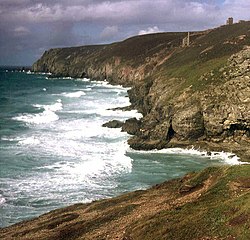Chapel Porth: Difference between revisions
Created page with '{{Infobox NT |name=Chapel Porth |county=Cornwall |town=St Agnes |picture=Mouth of Chapel Porth - 2 - geograph.org.uk - 998284.jpg |picture caption=The mout…' |
No edit summary |
||
| (One intermediate revision by one other user not shown) | |||
| Line 16: | Line 16: | ||
A stroll around the network of paths at Wheal Charlotte, Wheal Coates or Trevellas allows you to discover more of this World Heritage Site. | A stroll around the network of paths at Wheal Charlotte, Wheal Coates or Trevellas allows you to discover more of this World Heritage Site. | ||
[[St Agnes Beacon]], the hill rising above the | [[St Agnes Beacon]], the hill rising above the coast, and the surrounding cliff tops are one of the last remnants of a huge tract of heathland which once spread across Cornwall, and it is internationally recognised as an important ecological habitat for its wealth of wildlife and from late summer onwards comes alive with colour, forming a brilliant yellow and purple patchwork of gorse and heather. | ||
[[Category:Coves of Cornwall]] | |||
Latest revision as of 20:37, 13 December 2016
| Chapel Porth | |
|
National Trust | |
|---|---|
 The mouth of Chapel Porth | |
| Grid reference: | SW697494 |
| Information | |
| Website: | St Agnes and Chapel Porth |
Chapel Porth is a cove on the north coast of Cornwall, near St Agnes. It is part of a stretch of coastal cliffs owned by the National Trust. Beside it is another National Trust property, Wheal Coates.
A vast low tide beach and a sea of glowing heather make it hard to believe this area was once an industrial landscape.
The enigmatic buildings perched on the cliffs provide a reminder of St Agnes's tin and copper mining past.
A stroll around the network of paths at Wheal Charlotte, Wheal Coates or Trevellas allows you to discover more of this World Heritage Site.
St Agnes Beacon, the hill rising above the coast, and the surrounding cliff tops are one of the last remnants of a huge tract of heathland which once spread across Cornwall, and it is internationally recognised as an important ecological habitat for its wealth of wildlife and from late summer onwards comes alive with colour, forming a brilliant yellow and purple patchwork of gorse and heather.